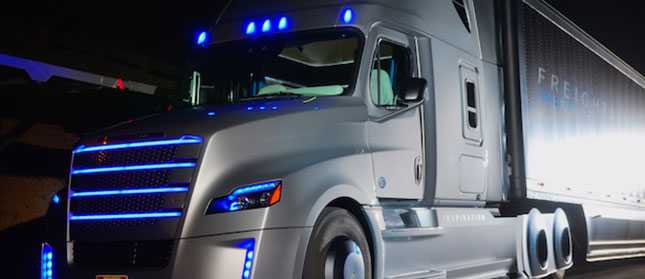
Despite concerns the coming age of so-called driverless trucks will usher in the demise of the long-haul truck driver, driving could in fact be a much more desirable job thanks to autonomous vehicles, according to top trucking industry engineers and analysts at the Commercial Vehicle Outlook conference.
How? Fleet Owner magazine reports:
“We’ve done a lot of end-user research to come to the conclusion that autonomous vehicles will enable recruiting drivers,” said Sandeep Kar, global vice president for Frost & Sullivan and an expert in heavy truck systems and technologies. “[Trucking] will need to entice young drivers by giving them a work environment that is less stressful, less disenfranchised—that enables them to connect to the world outside. They want to be connected to their friends, to Facebook or whatever it is: You have to give them some time during their work cycle where they relax, sit back and watch their iPad.”
Currently, just 11% of the truck driver workforce in the U.S. is under 30 years old, Kar noted.
“This is a huge red flag,” he said. “If we want to bet on the U.S. economy, we have to attract young drivers. On the other side, the health, wellness, and well-being of the aging drivers is becoming a major driver retention factor.”
As a result, truck makers are more focused than ever on “inside the cab,” based on the growth of investment on things like seating systems, visibility, steering, and the driver interface.
“It’s not by accident that we’re here to talk about automated mobility—it is by design, it is by reality,” Kar said.
Autonomous truck technology, he continued, will enhance driver performance: improved fuel efficiency, improved safety, improved compliance.
The catch, however, is that fleets will question the need to invest in the suite of technologies needed to achieve Level 3 autonomy (a truck that has the ability to take over the driving in certain situations, typically long highway stretches) if they also still have to pay drivers. But the substantial benefits to the supply chain and trucking operations that connectivity and big data will provide should mitigate those concerns, attendees heard.
Level 4 automation means no driver in the cab, and it’s “way out there,” Kar noted.
But the substantial market growth comes with Level 2 autonomy, or combined technologies that relieve the driver of control of each, which will hit 109,000 trucks in North America in 2025, and more than 200,000 in 2035.
“Long haul is the holy grail for any technology and, coincidentally, augmented driving applies the most in the long-haul truck market,” Kar said.
Ultimately, some agriculture, mining and defense niches are where the Level 4, fully autonomous vehicles will find a foothold.
“I’m not saying driverless trucks when they come in 2035 are going to take over the world,” Kar said. “But be prepared for a future where some trucking vocations will not require drivers.”
Derek Rotz, a manager in advanced engineering at Daimler Trucks North America, said the key for manufacturers is “full vehicle integration,” or harmonizing all driving operations. Therefore, the traditional a la carte approach, or picking and choosing from among various component systems, will need to be reconsidered with an eye toward using all the pieces working together.
“…Technology is really one piece of making automated driving a reality. It really requires all hands on deck: the industry, regulators, legal aspects, and infrastructure,” Rotz said.
Regardless, whether the future brings fully autonomous truck or platooning trucks, the technology experts here agree that human oversight will remain critical.

